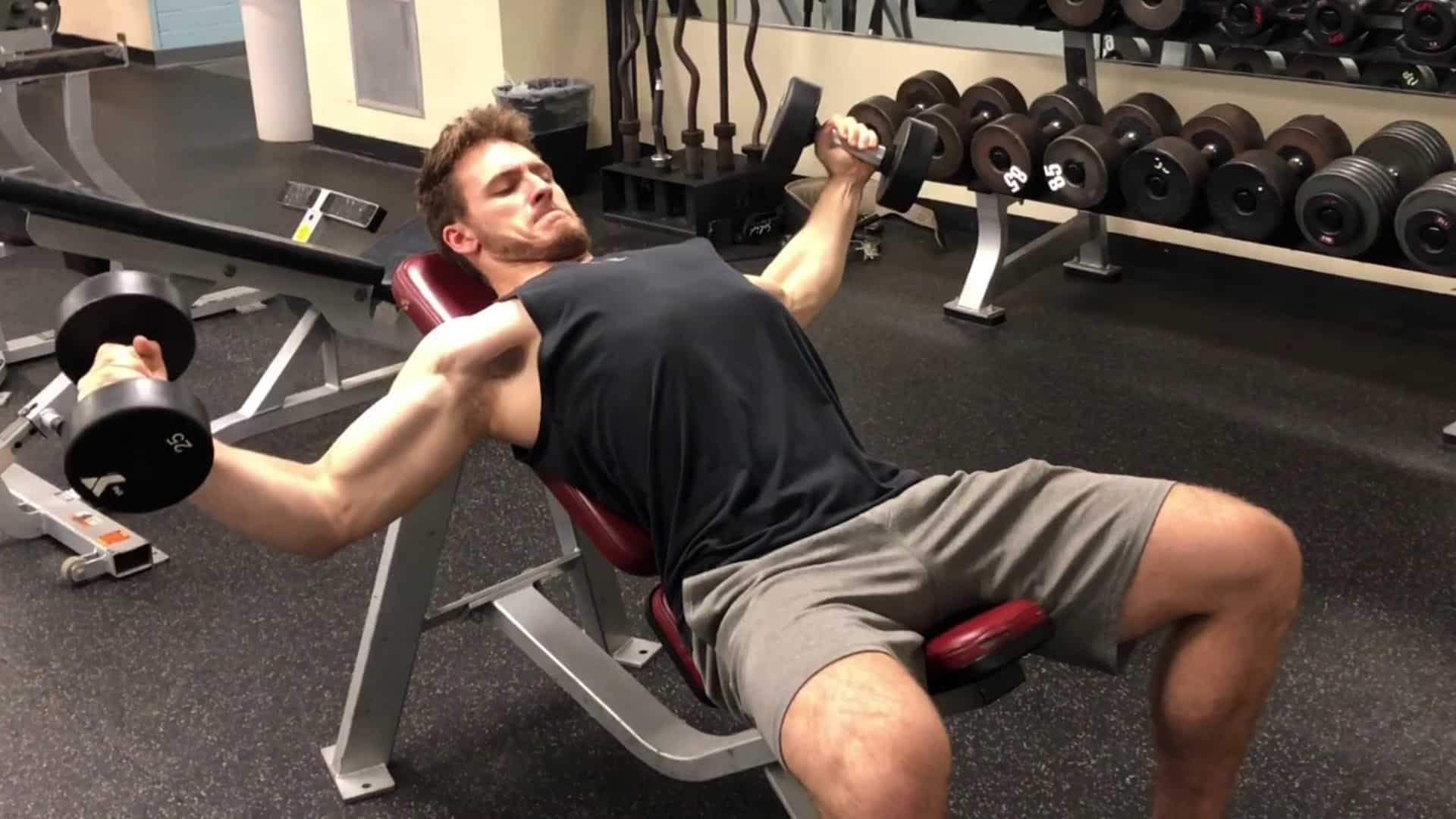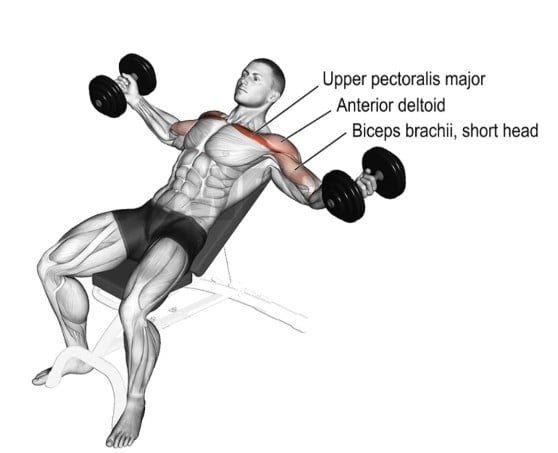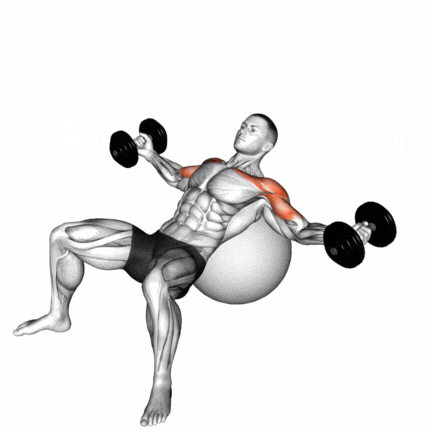If you want to build more thickness, muscle, and strength in your upper chest, you need to add an incline dumbbell chest fly to your chest workout.
The Incline chest fly is an isolation exercise usually performed after big compound lifts, such as the bench and incline press. This is a great way to strengthen your chest after doing bench presses.
The chest fly can help open up your chest muscles and improve your shoulder range of motion. When chest and shoulder muscles are stretched, they help to increase the range of motion in the shoulders.
A study published in the journal JSCR showed that the incline dumbbell fly is an effective exercise for increasing chest muscle size and strength.
There are different ways to do an incline dumbbell fly to build a bigger and stronger chest.
- Dumbbell One Arm Incline Fly
- Incline DB Twist fly
- Dumbbell Incline Chest Fly-On Stability Ball
Know Your Calorie Requirement To Build Muscle Mass

- Incline Dumbbell Fly Muscles Worked
- How To Do Dumbbell Incline Chest Fly
- Proper Form and Techniques
- Incline Dumbbell Fly Variations
- 1. One Arm Incline Dumbbell Fly
- 2. Incline Dumbbell Twist fly
- 3. Incline Dumbbell fly On Stability Ball
- Incline Dumbbell Fly Workout Routine
- 1. Chest Focused Workout Routine
- 2. Upper Body Workout Routine
- FAQs
- What muscles does incline dumbbell fly work?
- What is the best angle for incline dumbbell Flyes?
- Is the incline better than regular chest fly?
- References
Incline Dumbbell Fly Muscles Worked
- The incline dumbbell fly primarily muscle worked the upper chest
- The incline DB fly involves several synergist muscles, including Rhomboids, levator scapulae, Anterior deltoids, and Latissimus dorsi.
- A handful of other muscles worked or play the role of stabilizer muscles during the Incline DB fly, including your Biceps brachii, Triceps brachii, Wrist flexors, Obliques, and Rectus abdominis.

How To Do Dumbbell Incline Chest Fly
- Set an incline bench at a 30-45 degree angle. Make sure the bench is stable and secure.
- Sit on the bench with the dumbbells resting on your thighs.
- Carefully lie back and bring the dumbbells up so they’re directly above your chest. Palms face each other like you’re hugging a tree trunk.
- Slowly lower your arms to your sides until your wrists reach about shoulder level or slightly above.
- Once you feel the stretch in your chest, squeeze your pecs together and lift the dumbbells back to the starting position.
- Avoid locking out your elbows at the top of the movement.
- That’s one rep! Do 8-12 reps for 3-4 sets.
Proper Form and Techniques
- Set your incline bench to a moderate angle, typically between 30-45 degrees, don’t go beyond that, as the stress shifts more to the shoulders.
- Keep your chin tucked and your head and back firmly pressed into the bench.
- Keep your shoulders back and down, chest lifted, and core engaged. Avoid arching your back or shrugging your shoulders.
- Avoid lowering the dumbbells too far, as it can cause shoulder injuries.
- If you are a beginner, start with a light set of weights and gradually increase the amount of weight each week as you build strength.
- Pause at the bottom of the movement and feel your chest muscles stretch. When you are lifting the dumbbells back to the initial position, squeeze your chest muscles.
- Don’t let the dumbbells touch as they meet at the top.
- Keep your elbows bent. You should never fully straighten your arms or lock them out, as this forces the weight you lift onto the elbows and shoulder joints, increasing your chance of injury.
- Progressive overload your training regimen by gradually increasing the weight, repetitions, or sets. This gradual progression helps prevent plateaus and stimulates muscle growth.
- Allow your muscles adequate time to recover between workouts. Aim for at least 48 hours of rest before targeting your chest muscles again.
- Here are some general guidelines for the Incline dumbbell fly exercise, including sets, reps, and frequency, to enhance muscle mass.
| Level | Sets | Reps | Frequency |
|---|---|---|---|
| Beginner | 2-3 | 8-12 | 1-2 times per week |
| Intermediate | 3-4 | 8-12 | 2-3 times per week |
| Advanced | 4-5 | 8-15 | 2-3 times per week |
Incline Dumbbell Fly Variations
You can perform the incline dumbbell fly differently depending on the gym equipment and your preference.
- If you’re new to doing incline dumbbell flies, you might want to make the exercise easier. One way to counter this problem is to adjust the incline of the bench so that it is completely flat. Another is to use a lighter weight.
- Try the One-Arm Incline fly, and Dumbbell Incline chest fly on a stability ball for more advanced variations. Using heavier weights can make them more difficult.
1. One Arm Incline Dumbbell Fly
The Incline dumbbell one arm chest fly is a unilateral variation of the incline DB fly. This variation can help to improve muscle balance and isolation, as well as target the upper chest muscles more effectively.
There are many good reasons to do incline fly with one arm.
- Balance strength between left and right sides for an even chest.
- Enhance core stability, like a bonus workout for our tummy muscles.
- Greater hand movement helps to stretch and grow chest muscles.
- Improve mind-muscle connection for better exercise results.

How To Do
- Lie on an incline bench (30-45 degree inclined).
- Hold a dumbbell in each hand with your palms facing each other.
- Raise one arm up to the ceiling, keeping your elbow slightly bent.
- Slowly lower the dumbbell down to the side of your chest.
- Pause, then slowly raise the dumbbell back up to the starting position.
- Then repeat on the other side.
2. Incline Dumbbell Twist fly
The Incline dumbbell twist fly helps you better isolate the muscles of the upper chest. The contraction induced by twisting the weight is significantly greater than that typically experienced from the conventional incline dumbbell fly.
Additionally, it helps to improve the range of motion of the shoulders by stretching the muscles in the chest and shoulders.

How To Do
- Hold a dumbbell in each hand and lie on an inclined bench.
- Hold the weights above you at shoulder height.
- Slowly lower the dumbbells laterally while maintaining the angle at your elbow.
- Once the dumbbells reach chest level, reverse the movement by squeezing your pecs together.
- As the dumbbells return to the starting position, twist the handles so that the bottom of the dumbbells almost touch.
- Start the next repetition by untwisting the handles back to a neutral position, and continue until the set is completed.
3. Incline Dumbbell fly On Stability Ball
A Study has found that when doing dumbbell flyes on unstable surfaces, the pectoralis major, anterior deltoid, and serratus anterior muscles worked more than when doing them on stable surfaces(1).
It also helps you to improve your core stability and balance by making you balance on the ball while you do the exercise.

How To Do
- Start off by sitting on an exercise ball, gripping dumbbells in each hand.
- Slowly roll down on the exercise ball and make sure that your head and neck are on the ball with your feet planted on the floor ahead of you.
- Lift with the dumbbells and bring them straight up above your chest, squeezing throughout the entire motion.
- Hold on to this position for a few seconds, then return down to the starting position.
Incline Dumbbell Fly Workout Routine
They can be incorporated into your workout routine in various ways. Here are some options:
- As a standalone exercise: Do on 3–4 sets of 8–12 reps.
- As part of a chest workout: Do them along with other chest exercises.
- As part of a full-body workout: Do them with other compound exercises like squats, deadlifts, and bench presses.
1. Chest Focused Workout Routine
| Exercise | Sets | Reps |
|---|---|---|
| Push Ups | 4 | 8-10 |
| Barbell Bench Press | 4 | 6-8 |
| Decline Bench Press | 4 | 10-12 |
| Incline Dumbbell Fly | 3 | 8-10 |
2. Upper Body Workout Routine
| Exercise | Sets | Reps |
|---|---|---|
| Cable Rows | 4 | 8-10 |
| Pull-Ups | 3 | 8-10 |
| Dumbbell Bench Press | 3 | 8-10 |
| Seated Cable Rows | 3 | 12-15 |
| Incline Dumbbell Fly | 3 | 10-12 |
| Dumbbell Tricep Extension | 3 | 10-12 |
FAQs
What muscles does incline dumbbell fly work?
The incline dumbbells fly primarily works the upper chest muscles (pectoralis major), as well as the front shoulders (anterior deltoids) and the triceps.
What is the best angle for incline dumbbell Flyes?
The best angle for incline dumbbell flyes is typically between 30–45 degrees. This angle allows you to effective target of the upper chest muscles and also helps to reduce stress on the shoulder joints.
If you are new to incline dumbbell flyes, it is a good idea to start with a lower angle, such as 15 degrees.
Is the incline better than regular chest fly?
Both incline and regular chest fly exercises have their unique benefits, and the choice between them depends on your fitness goals and preferences.
Incline dumbbell flyes target the upper chest muscles, while regular dumbbell flyes target the entire chest. This means that incline dumbbell flyes are a good choice if you want to build the upper chest, while regular dumbbell flyes are a good choice if you want to build the entire chest.
Incline dumbbell flyes can also be helpful for people who are prone to shoulder injuries, as the incline position of the bench helps to reduce the stress on the shoulders. However, regular dumbbell flyes can also be done safely, as long as you use proper form.
Thanks for reading.
Stay Fit, Live a Happy and Healthy Life
References
- Tom Erik Solstad, Vidar Andersen, Matthew Shaw, Erlend Mogstad Hoel, Andreas Vonheim and Atle Hole Saeterbakken: A Comparison of Muscle Activation between Barbell Bench Press and Dumbbell Flyes in Resistance-Trained Males.
- Reiser FC, Lira JLO, Bonfim BMA, Santos Filho SJA, Durante BG, Cardoso JMD, Miotto H, Soares MAA, Bonuzzi GMG, Tavares LD. Electromyography of Dumbbell Fly Exercise Using Different Planes and Labile Surfaces. JEPonline 2017;20(6):31-40
- Behm DG, Leonard, AM, Young WB, Bonsey, WAC, MacKinnon SN. Trunk muscle electromyographic activity with unstable and unilateral exercises. J Strength Cond. Res. 2005, 19, 193–201.

Manish is a NASM-certified fitness and nutrition coach with over 10 years of experience in weight lifting and fat loss fitness coaching. He specializes in gym-based training and has a lot of knowledge about exercise, lifting technique, biomechanics, and more.
Through “Fit Life Regime,” he generously shares the insights he’s gained over a decade in the field. His goal is to equip others with the knowledge to start their own fitness journey.
